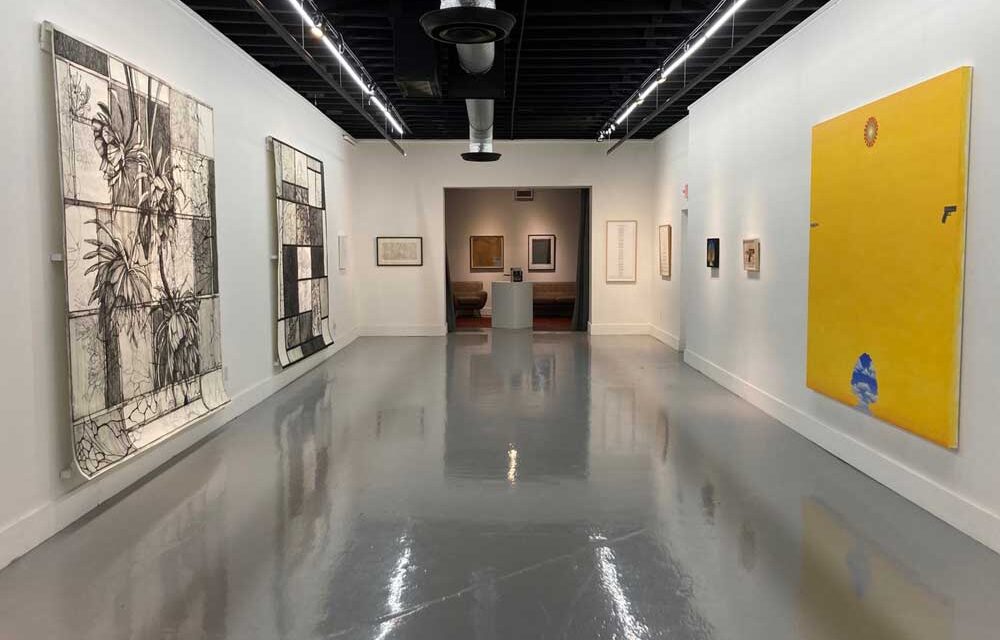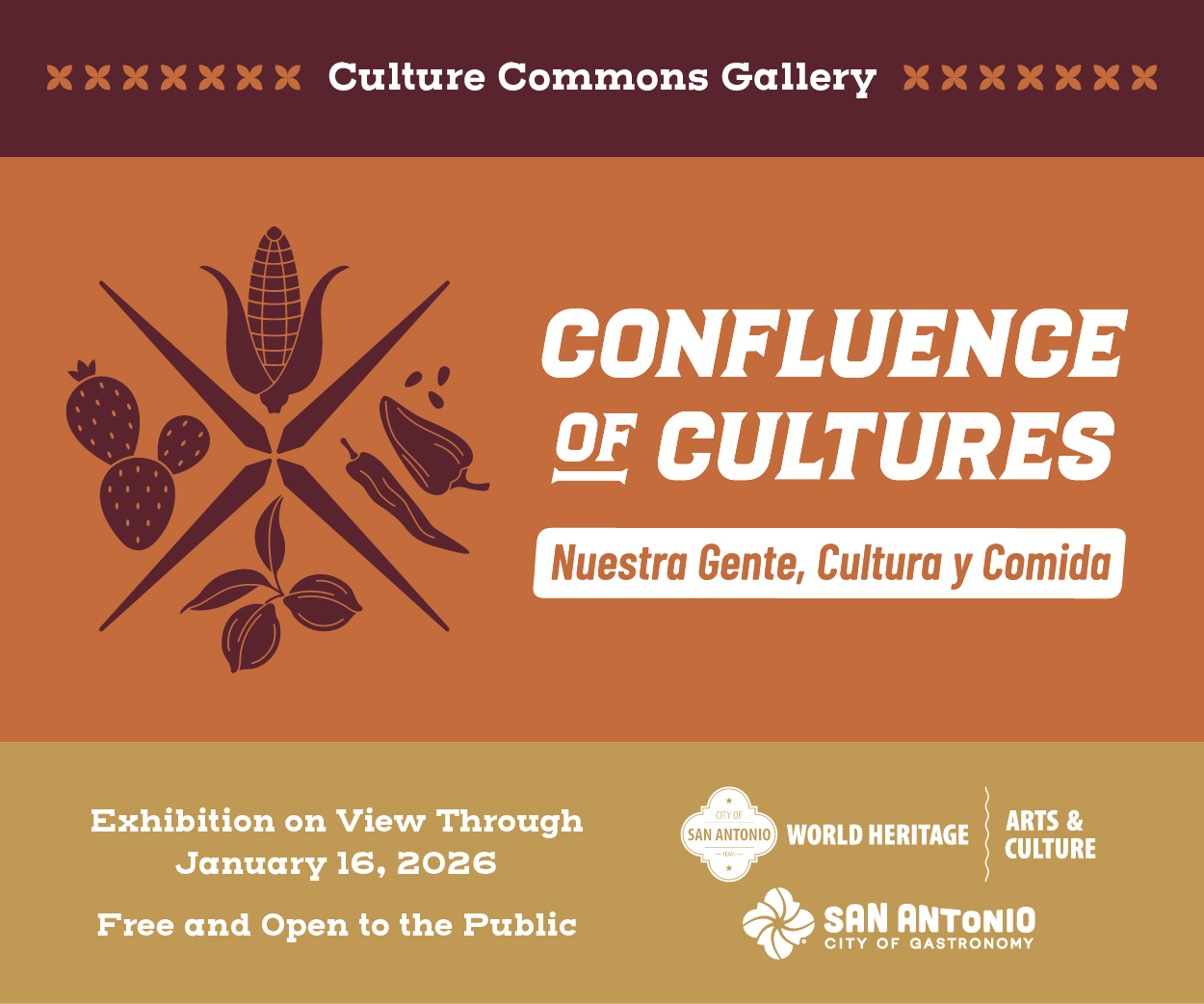A long anticipated art show featuring the work of the multitalented North Texas Latino artist, Benito Huerta, opened recently at the Kirk Hopper Fine Art gallery in Dallas. Huerta is part of a two-person exhibition with his wife Janet Chaffee. He told Texas art magazine Glasstire that the exhibit includes a sampling of his sculpture, painting, drawing, and print work. He described the subject matter as “an amalgamation of political, economic, and social commentary along with personal identity and pop culture references.”
Huerta is an important and well-known figure in Texas art circles. His career embodies nearly fifty years of involvement as an artist, curator, educator and champion
of diverse creative voices. Although I was unable to attend the show’s opening because of an ice storm, I am familiar with Huerta’s commissioned public art works at Terminal D of the Dallas/Fort Worth International Airport, the Henry B.
Gonzalez Convention Center in San Antonio, and the Mexican American Cultural Center in Austin, Texas. These large art works have given Huerta great visibility over the last two decades.
Huerta was born in Corpus Christi, Texas but grew up in Houston after his family moved there when he was in middle school. His new community, Bellaire, was largely Anglo, and Huerta experienced his first encounters with prejudice and racism. His interest in art evolved slowly. It was not until his senior year at the University of Houston [UH] that he found his artistic voice. He told Cary Cordova of the Smithsonian that he started painting in his last year at UH when he realized that he had a significant number of electives to take to graduate. As a consequence, he “started taking painting, advanced drawing, lithography, watercolor, and short story writing, and I excelled in all those classes and really, for the first time, I started enjoying myself in school.”
After completing studies at the University of Houston, Huerta took the advice of one of his art professors who encouraged him to apply to graduate school. When New Mexico State in Las Cruces offered Huerta a scholarship, he jumped at the opportunity. A highlight of his experience
at New Mexico State occurred when one of his instructors bought one of his paintings. Huerta told the Smithsonian: “So, nobody ever really bought a painting of mine, and now here a faculty person was buying one. I felt really good.”
Huerta co-founded the Texas art journal Art Lies in the mid-1990s and curated several groundbreaking art shows. He organized the first traveling retrospective of Latino artist Luis Jimenez. University of Arizona professor Gary Keller followed Huerta’s work over many years and wrote that the artist had a fascination with the power of images. Keller explained, “His oeuvre is replete with works that utilize, exploit, and expound upon the multiplicity and power of symbols, the results being objects that elicit contemplation, investigation, and reverence.”
Huerta moved to San Francisco and then New York after graduating from New Mexico State and began painting in earnest. His painting for his first show in 1976 portrayed a deceased young Black boy with a police chalk outline on the sidewalk of where the body once laid. Early in his career Huerta used his art to call attention to
violence and political action. In his artist’s statement he commented: “Issues of race, fear and violence are current topics in my work as a reaction to the current political climate which has become racially divisive, economically polarizing, politically nationalistic and physically violent at times.”
After the 1980s Huerta’s work was in high demand. In his first two decades as an artist he participated in 137 group exhibitions and 22 solo shows. Over his twenty-five years at UT Arlington [1997-2022], Huerta’s art was featured in 41 solo shows and in 188 group exhibitions. Huerta expanded on his artistic philosophy to Glasstire when he commented: “I like that aspect of art making because we’re problem solvers. We create our problems and then try to make those problems or issues or concepts work. It’s almost like the work takes a life of its own and dictates or leads you to go in a direction you never even thought of.”
The Mira! Canadian Club Hispanic Art Tour in the mid and late 1980s was a major artistic breakthrough for Benito Huerta. Mira! became the first major Latino traveling exhibit, and participant selection was highly competitive. Joining Huerta in the exhibit were several notable Latino Tejanos including Nivia Gonzales, Cesar Martinez, Jesse Trevino, and Alberto Mijangos. Cesar Martinez’s well-known piece, Pantalon Rojo, won first prize in round one of the Mira! exhibit and Huerta’s Tres Equis won first prize in the second round of Mira! when it opened at the Museo Del Barrio in New York City in 1985.
Huerta gained significant national presence with his Mira! $5,000 first prize award for the “Tres Equis” painting shown at the Museo del Barrio in New York City. However, the timing for this award conflicted with another important show, the Hispanic Art in the United States exhibit, that had selected two of his works, Tres Equis and Schizophrenia. When the Hispanic Art curators requested the same art pieces for their show, the
sponsors, Canadian Club, were unwilling to remove the piece from the Mira! exhibit. Although he was disappointed at not being included in Hispanic Art, Huerta went on to other important shows over the next two years in Florida, Texas, Kansas, Arizona, Colorado and California– in the years immediately following Mira! [1988-1990].
Benito Huerta was also one of the artists chosen by the McNay Art Museum for the Estampas de la Raza: The Romo Collection show in 2013. That exhibit traveled to Albuquerque, Los Angeles, Raleigh, Sacramento, Chicago, Delaware, Atlanta, and Jersey City. His superb art piece in the Estampas show, “Cast of Characters,” was printed by Sam Coronado in Austin. Coronado also had several of his works in the Estampas collection. Over a ten year period Harriett and I purchased three large portfolios from Coronado, a total of 750 serigraph prints. We donated the Coronado portfolios to UT Austin’s Latin American Collection, the McNay, and the San Antonio Museum of Art. Huerta’s prints are in major Texas museums and the University of Texas collection in Austin.
When Huerta joined the Art Department of the University of Texas at Arlington in 1997, he assumed the Director/Curator position at The Gallery of UTA. Over the
next 25 years Huerta brought major Texas artists to the UTA campus and gave Latino artists a presence in the Dallas-Fort Worth-Arlington complex. A UTA newsletter
noted that during his tenure Professor Huerta “developed a guiding philosophy of showcasing contemporary work by exemplary artists who reflected the world in all of its diversity.” His colleagues in the art department praised his “incredible gift for curation, tireless and proactive relationship-building and mentoring, seemingly endless energy, and modeling excellence as an accomplished artist himself.”
Huerta’s participation in exhibitions is impressive given that he taught full-time as an art professor and devoted hours to being the director/curator of The Gallery at UT Arlington. Huerta’s accomplishments in hosting exhibitions at The Gallery at UTA are impressive. Art historian Heather Sealy Lineberry’s commentary on Huerta’s work merits repeating. She wrote, “Huerta has focused upon work that is anchored to content–whether covert, overt, or ambiguous–a tendency that many Latino artists share.” She added, “Huerta adamantly refused to accept limitations and prejudice inherent in the designation ‘Chicano artist’ for his concerns range far beyond his cultural heritage.”






